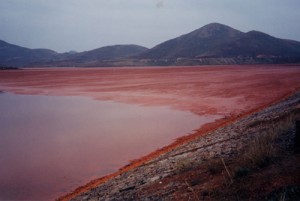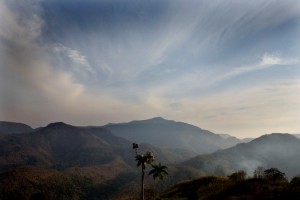
An answer to Venky Vembu’s article ‘Jairam is wrong: It isn’t mining that causes poverty’ written after Jairam Ramesh’s januray visit to Niyamgiri mountain.
By Felix Padel and Samarendra Das
The comment from Jairam Ramesh that mining often leads to greater poverty (reported Economic Times 14th January) is a welcome admission from a senior Minister of the Central Government. Anyone who knows the situation of tribal people in areas whose landscape is now dominated by mining and metals projects knows how deeply this is true – a truth amply confirmed for example by the Centre for Science and Environment’s survey Rich Lands, Poor People: Is Sustainable Mining Possible? (Delhi 2008) This brings extensive evidence and statistics to show that, basically, India’s mining areas suffer the most acute poverty, as well as systemic human rights abuses by the mafias, goondas and scamsters surrounding mines.
Venky Vembu’s attack on Jairam Ramesh’s words reveals an entrenched ideology: the mainstream belief that mining-based industrialization is the basis of development, and can uplift backward areas. This is contradicted by the logic of the Resource Curse, which explains not just why some of the countries richest in resources are poorest (e.g. Congo), but why resource rich regions within a country remain poor (e.g. Odisha): basically because resource wealth attracts the most hideous forms of exploitation. Whether one looks at coal mining, iron ore mines, the chromite quarries of Sukinda, near Kalinganagar, that the Blacksmith Institute has listed as among the ten most polluted places on earth, or bauxite mines and aluminium factories, one finds an appalling level of poverty and abuse that no amount of ‘Corporate Social Responsibility’ can hide.

For example, after 30 years of aluminium-based development based around India’s biggest bauxite mine run by Nalco, Koraput district has some of the worst poverty indicators of any district in India – not the impression the aluminium industry promotes! For one thing, the Damanjodi refinery has produced a tonne of toxic red mud for every tonne of alumina – a series of toxic lakes that has leached into and poisoned a wide area, as red mud inevitably does. For another, Panchpat Mali – which India’s environment secretary T.N. Seshan once said should take care of India’s aluminium needs for the next hundred years, since the impact of bauxite mining and heavy subsidies on electricity etc are so great – has virtually dried up as a storehouse of water: its perennial streams are perennial no more. Also, Damanjodi has been reported in the international press as home to about 500 sex workers. Mining projects are surrounded by prostitution, illegal alcohol shops, and numerous forms of exploitation that prey on the local people displaced and forced to work there.
Tribal people who live around Niyamgiri, Bapla Mali and other mountains in Kashipur, and the great mountains in Jerella and other areas under threat in northeast Andhra Pradesh often identify these mountains as sacred sources of life, understanding how perennial streams form out of the rich minerals near the summit of these mountains. This understanding receives backing from science. Aluminium’s power of combining with other elements – which make it such a key metal for hi-tech aerospace/defence alloys and applications – starts from bauxite, where it combines with H2O to hold monsoon rainwater in suspension. A report from the Central Mining Planning and Design Institute (Ranchi) has claimed otherwise, though close examination shows how ludicrous is its claim that bauxite mining enhances groundwater: the idea is that micro-cracks that develop in the side of a mined mountain ‘improve the run-off and replenish the groundwater’! What this means in practice is that monsoon rain falls straight off the mountain, and as a storehouse of water and source of the springs that feed rivers, the vital role that mountains play in ecosystems is undermined. A mountain mined of its bauxite capping is no longer a source of fertility for miles around.

This is why ‘The Wealth of the Mountains is the Health of the plains’. The belief that Odisha’s minerals are ‘lying unutilized’ at the top of the mountains is based on a dangerously short-term understanding of ‘wealth’. As tribal activists often ask, how can we call a mining project ‘development’ when it basically destroys our land and livelihood to create huge profits for a small number of individuals and traders based far away in the world’s capitals, who sell a significant part of the smelted minerals for war planes and missiles?
Anil Agarwal, writing in Times of India (10th January), expresses the ideology of mining-based industrialization at its most extreme in his frank admiration for America’s ‘captains of industry’, who made their country ‘great’, such as J.P. Morgan and Henry Ford. These individuals are often known as the ‘robber barons’, because they ‘robbed the public blind’, stole land from America’s indigenous communities in one of the world’s worst genocides, and established norms of corruption, tax avoidance and manipulating finance in high places that have gone viral world-wide, while exhibiting corporate ‘munificence’ through Trusts and ‘good works’ in a top-down, ‘charity’ model, that continues to fool the naïve and gullible and act as a smokescreen for their robbery and manipulation of Law.
Producing one tonne of steel consumes over 40 tonnes of water according to the esteemed Wuppertal Institute for Climate, Environment and Energy. This fact alone, and the diminishing water available for farmers around the Hirakud dam in northwest Odisha, should make one question whether India’s rising steel production is of any benefit to rural areas. Producing a tonne of aluminium consumes over 1,000 tonnes of water, spelling death for rural communities in a situation where the ground and river water that life depends on is diminishing rapidly throughout the country.
As for coal, Jairam’s attempt to reserve just a third of India’s coal deposits as ‘no-go areas’ was ridiculed and overturned, even though a TERI report has warned that at present rates of extraction India’s coal deposits will last just 40 years. Extraction rates are increasing, the country is already importing large quantities (especially from Indonesia, whose forests and tribal communities face even worse conditions than India), and the impact of coal mining on India’s forest areas is immensely destructive for ecosystems as well as in terms of human costs.
The ideology of a big expansion in mining is driven by myopic lack of awareness and concern for future generations, for India’s ecosystems, and for the tribal communities who have always lived in and respected our forests and rivers. Citing Australia and Mongolia as positive examples reveals a similar ignorance about appalling impacts on indigenous communities in those countries. The lifestyle we consider normal now, based on a high consumption of metals and oil products, is an artificial bubble, that keeps most people poor while promising them the earth.
To accuse Jairam Ramesh of ‘Ecological Evangelism’, and environmental restrictions of causing poverty reveals a gross ignorance about the facts about ecology and ecosystems that a healthy economy depends on, and about the process of displacement that has caused misery to at least 10 million tribal people in India.
These issues are discussed in depth in Felix Padel and Samarendra Das’ joint book ‘Out of This Earth: East India Adivasis and the Aluminium Cartel’ (Orient BlackSwan 2010).